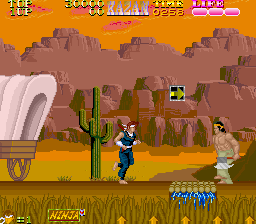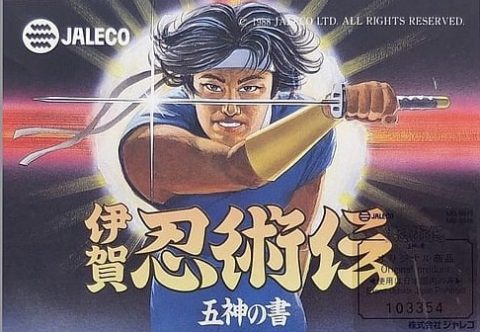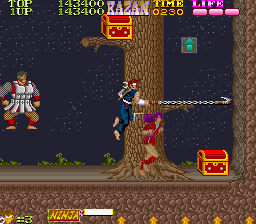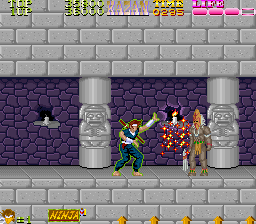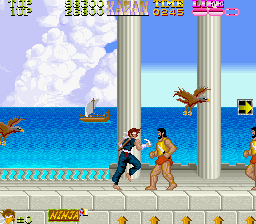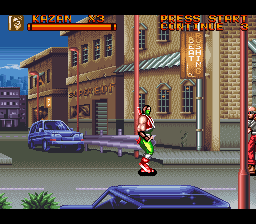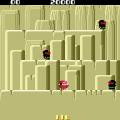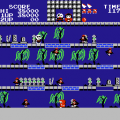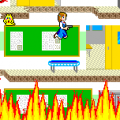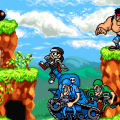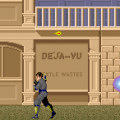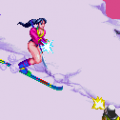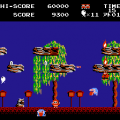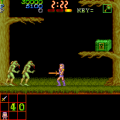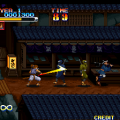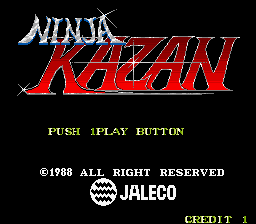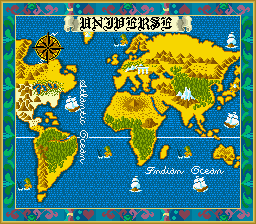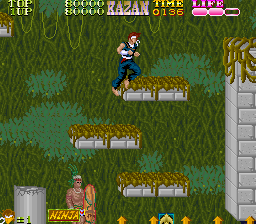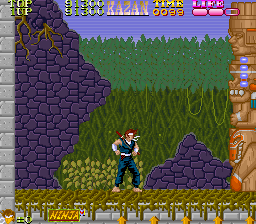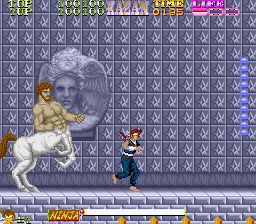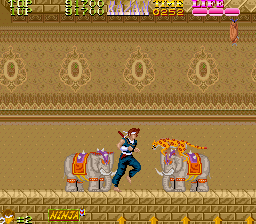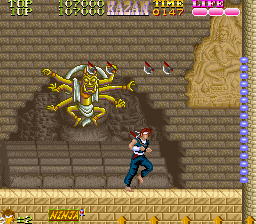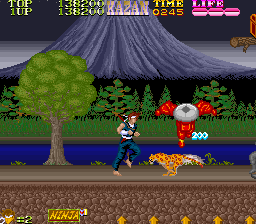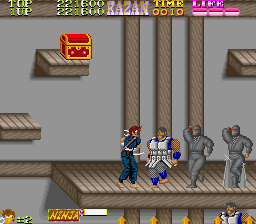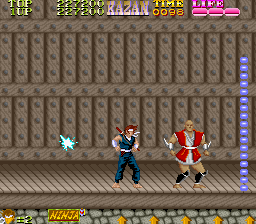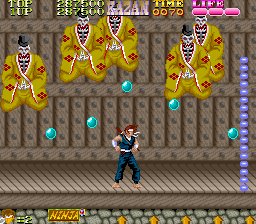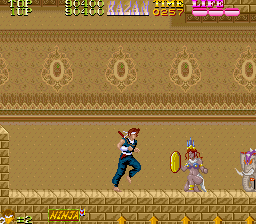Fans of 80s arcade games are no doubt familiar with ninjas like Joe Musashi from Sega’s Shinobi and Ryu Hayabusa from Tecmo’s Ninja Gaiden. One of the lesser ninja dudes is Kazan, star of Jaleco’s self-titled action game Ninja Kazan, known in Japan as Iga Ninjutsuden: Goshin no Sho (“Iga Ninjutsu Story: Books of the Five Gods”). Kazan travels the world (or the “universe”, as the map screen puts it for some reason) in order to find five “letters” that have been stolen, then returns to his home country in Japan for the final confrontation.
Kazan comes equipped with a basic sword to mow down foes. Throughout each stage are elderly men that will grant him a new, upgraded weapon, beginning from shurikens to kusarigamas (a chain and sickle) to knives. These allow you to attack at a greater distance, but you’ll lose them if you die. (During the levels, you can always backtrack and revisit one of these if you want to re-obtain a lost weapon.)
But much more powerful are Kazan’s own magic powers, which are cast by holding down the attack button for a certain amount of time. At the beginning, you can shoot a fireball, which takes about two seconds to charge and mows down multiple enemies at once. Each level grants you a new magic spell, which in turn takes two more seconds of charging to use. These include the Blizzard Wave which actually looks more like a cloud of sparkles, which is larger and travels farther than the Fireball; the Lava Beam, which shoots flames in a cross-shaped pattern, horizontally and vertically; the Electric Bomb, which causes an explosion around Kazan; and the Dragon Quake, which attacks everything on the screen, even enemies that are flying. There’s no limit on how often you can cast these spells, as long as you can charge them up long enough. The Dragon Quake is, of course, super powerful, but it also takes twelve long seconds of charging, during which you can’t attack at all.
Enemies attack quickly but most can be cut down with a single attack, and even the ones with stronger defense have a tendency to jump over you, allowing you to score the second killing blow if you can dodge them. Even many flying enemies will politely soar right over your head if you duck.
The levels in Ninja Kazan are relatively open, allowing you to explore for additional treasure chests or find where the kindly weapon-giving man is hiding. But while they’re well constructed, with a large number of platforms to jump across and enemies to fight, they certainly feel long. Most stages give you a time limit of five minutes, and if you spend too much time exploring or fall too many times and need to backtrack, it’s very likely that you’ll bump up against the clock and end up losing a life.
Kazan can take three hits before dying, which is actually more than in games like Shinobi or Ninja Spirit. But losing a life also means getting sent back to either the beginning of the stage or a mid-level checkpoint, and continuing from a game over means restarting the stage. And due to the size of the levels, trudging through them can be a bit tiresome.
The pacing does move pretty quickly, as Kazan can use his weapon while walking, allowing you to mow down enemies without ever needing to stop. However, the action does stop for a split second every time you magic spell, undoubtedly used for dramatic effect but something that grows a bit tiresome if you’re constantly throwing fireballs.
The boss battles can be tough, particularly since most of the later foes have multiple forms, and with them, multiple life bars. But at least the game is generous enough to let you respawn right before them, even when continuing. And while you may be stuck with a crappy sword, at least you always have your magic, so you have a fighting chance when you retry.
The world traveling theme gives Ninja Kazan a unique identity, though it’s handled in a pretty questionable manner. The first level takes place in the American desert, where you’ll spend the entire stage murdering Native Americans. The second level sends you to Africa, where you invade some sacred ruins and kill plenty of indigenous soldiers.
Reality breaks down completely by third level, which takes place in Greece, which is filled with armored centurions, winged creatures, and half-horse monsters straight out of mythology. Perhaps you’ve warped to the past? The fourth level takes place in India, where you’ll fight miniature armored elephants and scantily-clad swordswomen, who jiggle their bosom as they saunter forward. The fifth and sixth stages return to some semblance of normalcy, where you’ll fight ninjas and enemies that at least make it seem like they’re from the modern era. The fact that Jaleco clearly didn’t put much stake in realism, making its cultural insensitivity a little more forgivable.
Visually, the game looks fairly average, with large sprites that lack distinctive features. The large, sprawling layouts combined with the small tileset is undoubtedly the reason why the levels feel as long as they do. But some of the music tracks do manage to be pretty catchy.
Ninja Kazan doesn’t quite size up to the better ninja arcade games, or action arcade games in general, as it really needed some tighter design. But it’s also not nearly as frustrating as many games of the era either, as it’s challenging but fair for the most part, making for an agreeable if not outstanding experience. Jaleco never brought the game to the Famicom, even though it’s a better game than The Astyanax, released around the same time, that did get a home port. Perhaps there were already too many ninja games, especially Jaleco’s own Ninja Jajamaru series, which was far cutesier and also cast across different genres. It did eventually get a home release as part of Hamster’s Arcade Archives in 2021.
Jaleco didn’t entirely forget about Kazan though, as a ninja with the same name was featured in the SNES beat-em-up Brawl Brothers. Their design is completely different, though it’s not like Kazan’s arcade game design was particularly unique, but it’s likely they’re meant to be the same character.
